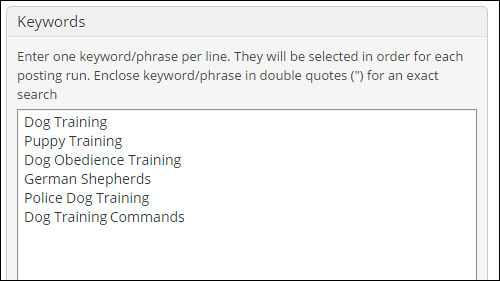 This tutorial is part of a series of tutorials we provide on content marketing and web content creation! We recommend subscribing to our FREE content creation course to learn how to create great content for your website or blog.
This tutorial is part of a series of tutorials we provide on content marketing and web content creation! We recommend subscribing to our FREE content creation course to learn how to create great content for your website or blog.
***
Content Marketing With WordPress – Using Content Writing Software
This tutorial series covers different methods you can use to create content for your site using third-party content.
These methods also include:
In this tutorial, we look at using content writing software.
Content Writing Software
In previous tutorials, we looked at reasons why you don’t always need to create content from scratch, and how to create unique enough content for publishing new articles and blog posts to your website or blog by rewriting existing content.
Let’s explore some more shortcuts for creating web content, starting with software that claims to “write content” for you.
Are there tools that can help you write content?
Yes, there are, but you need to approach some of these tools with caution.
Autoblogging Content Writing Software
Autoblogging or Autoposting is a method of creating web content automatically using software that finds, scrapes, or curates content from various sources. The content created by the autoblogging tool is related to keywords that you specify in the tool settings …
(Autoblogging tools find content based on the keywords you specify. Source: CovertVideoPress)
Once you enter keywords into your autoblogging software, the tool then drip-feeds content to your WordPress site or blog at regular or random intervals, depending on the settings you have specified …
(Autoblogging tools find and post content automatically to your site. Source: CovertVideoPress)
Problems Of Using Autoblogging Content Writing Software
There are autoblogging tools that promise to automate the entire content writing process and save you time writing content by creating unique, human-readable content for you at the “click of a button” and then automatically populating hundreds of blogs with drip-fed “search engine friendly” content.
While many tools make impressive claims, some are completely “hyped up” and often fail to deliver on their promises in one or more of the key areas.
For a start, many automated content writing tools “create” content by scraping content from other sites. Essentially, they do not create content, they simply copy content that has been written by someone else. Scraped content is not original or unique content, as it has been published elsewhere (often multiple times and verbatim).
If you publish scraped content as is on your site, you would not only be plagiarizing it (many call this “stealing”), but you could also leave yourself open to receiving copyright infringement and “cease and desist” notices. At least you will attract a lot of negative karma online, as you are not really providing any value to online users.
![]()
There are tools and services you can use to check if the content you are using has already been published on other sites. We cover these in other tutorials.
QIQO, Not GIGO
Have you heard of GIGO?
It stands for “Garbage In Garbage Out.”
Human readers have a great capacity for spotting “garbage” content. Most of us have had the experience of landing on a website we thought would contain useful or relevant information only to be confronted by garbage content drowning in advertising and immediately wanting to hit the “back” button on our web browser.
If your goal is to improve your search engine rankings and attract more visitors by publishing content to your website or blog on a regular basis, we recommend using a QIQO (Quality In, Quality Out) approach, not a GIGO one.
Have a look at the paragraph below. It supposedly contains content that is “readable” by humans:
### SAMPLE ARTICLE START ###
Social Media Within the Niche
You’re most likely at ease with how useful social media tools may be when the involves getting attention for your business. Really, websites are becoming this type of salient subject recently it’s created a unique marketing acronym- similar to SEO has Search engine optimization, websites have Social Networking Optimization, or SMO.
Yes, it’s true – you will find individuals who earn a living by modifying the Twitter accounts and Facebook profiles of individuals and corporations. The positive factor occurs when you’re somewhat operation, there’s without any reason you cannot manage your own personal social networking optimization.
There’s hardly any concerning the process that’s very hard – probably most likely probably the most annoying factor about here you go may be time-consuming, which describes why some companies decide to delegate the job.
Whenever your social networking optimisation reaches a particular point, you may deem it essential to delegate it too, but additionally for those who are basically beginning on the road to social medial optimisation, it’s recommended that you just assume control applying this yourself.
### SAMPLE ARTICLE END ###
The above content was created entirely by content writing automation software promising “human-readable” content. You can decide for yourself how readable this content is and whether you would be comfortable publishing content like this on your website with your name on it.
![]()
If you plan to use automated content tools to fill up hundreds of websites and blogs with scraped or reassembled content with the aim (“hope”) that this will rank your sites higher in search engines and drive visitors to click on ads that will make you money, you will be greatly disappointed. Apart from not adding any value to visitors and cluttering the web with meaningless “garbage,” you will most likely end up investing a lot of your time, energy, and money into a strategy that will ultimately deliver you ever diminishing returns.
Although you can set up networks of autoblogged websites quickly with “set and forget” tools that automate the entire process with a few clicks of the mouse, owning hundreds of domain names to host all of your sites will end up costing you thousands of dollars a year in domain renewal fees and most of these sites won’t even earn you enough each year in ad revenue to cover the cost of renewing the domain name you’ve built your site on.
Google’s main business model relies on helping users find meaningful results when searching for information online. Google also competes with sites like Facebook for mindshare and “eyeballs” (i.e. time spent online). To ensure that their search engine remains relevant to users, Google spends billions of dollars each year on people and technology to improve and update its search algorithm in order to prevent people from gaming their search results, so the simple advice is, don’t do it.
Don’t try to “beat” Google using software that promises to shortcut the process of creating quality content and deliver you better search engine rankings, but only end up creating garbled and unreadable garbage that adds no value or unique benefits to your visitors’ experience.
If you truly care about your business and your reputation, don’t compromise your integrity with rubbish or scraped content. You will simply be wasting your time, your visitors’ valuable time and risk being penalized in the search engines.
Here’s a simple test you can do if you plan to use content writing software …
Read the content before adding it to your site. If you think it will add unique value or benefit to users, then, by all means, consider using it on your site. If, however, the content fails to hold your interest or to motivate you to take any kind of action, then more likely than not, it will have the same impact on anyone else who reads it.
Are There Any Good Uses For Autoblogging Tools?
In moderation, autoblogging tools can be useful for adding things like:
- a “News” section from news websites and feeds.
- Videos from YouTube on specific topics to a “video tutorials” section,
- Product items from feeds (e.g. an affiliate Amazon store, etc.)
![]()
To learn more about using autoblogging tools to add content to your WordPress site or blog, see the tutorial below:
Summary
Avoid trying to game search engines with rubbish content or information that adds no real value to users. This strategy WILL backfire on you! When it comes to publishing content on your website and building your reputation online, choose QIQO (“Quality In, Quality Out”), not GIGO (“Garbage In, Garbage Out”).
Action Step
Be careful about buying into “hypey” software that promises to free up your time and grow your business online by automating the work of creating high-quality content. Make a decision that whatever your content strategy is (i.e. do it yourself, use software or employ others to write it for you), you will always aim to provide content with information that adds real VALUE to users and benefits your readers.
So … how can you add value to web users simply by rewriting existing content already found on the web?
You can add value to your visitors if you rewrite existing content where the end result achieves one or more of these objectives:
- The content adds a unique new perspective on the topic you are writing about.
- You make the content better than the original.
- You inject your expert knowledge or experience into the content in order to help people get a better understanding of the topic
- You save people time searching online by filtering, condensing, reorganizing and presenting information in a more convenient and easily digestible format.
Let’s take a look at these options.
Adding Your Unique Perspective
Sometimes, all you need to do is rewrite existing content for an opening or closing section for an article, blog post or tutorial that you are planning to write about where you already have an original idea for content that will help your readers gain a unique new perspective on the topic.
This is not that hard to do, especially if you are writing about your business, area of interest, or something that you are truly passionate about. You are a unique individual with a unique and individual perspective on things, so you can always present existing information from a new angle or perspective … yours!
Making It Better Than The Original
Sometimes you will come across sites with expertly written articles that have been well researched and that cover the topic you were planning to write about extensively.
When you come across these sites, don’t despair (and certainly don’t try to copy and paste sections of the article into your website and claim it as your own!) Go through the content and copy the URL of the page. You can boost your own authority and save time simply by quoting one or two sections from the page in your article and then giving the source credit. The content might even inspire you to write about a different angle (i.e. “add a unique perspective” of your own).
More often than not, however, you will find many poorly-written articles on a great topic idea. This is because people often outsource their content writing to cheap freelance writers who write generic, “fluffy” content for SEO purposes. Many businesses pay for SEO services and get back a list of keywords, on topics to write content about. The business owner then hands this list of keywords to a freelance article writer and publishes whatever they get back, often without spending much time making further edits and improvements.
This leaves you with a lot of room for improving the content.
If you are good at what you do, then you probably have a greater level of expertise and knowledge about your business, products, services, or industry than most of the people you will be outsourcing your content writing to. In this case, you should be able to easily spot situations where your competitors have effectively paid for expert research on the topic and created an outline that you can easily expand and improve upon. You can then turn a “thin” article into a high-quality piece of content with real substance that others will want to reference and link to from their websites.
Add Your Knowledge, Experience Or Expertise
If you have been doing something for a while, chances are that you are probably an expert on the subject, or have unique, specialized knowledge about it.
Consider, for example, someone who works in the travel industry. They should be able to take something like a special deal from a newsletter (e.g. “Special Deal – 7 Nights In Europe”) and write an almost infinite number of articles around that topic, simply by injecting their knowledge, expertise, experience, interest, and passion into the content. For example, they could create unique travel-related accounts that contain interesting “insider” tips and secrets like alternative or cheaper transport, travel, or accommodation options, lesser known tourist landmarks that should not be missed, great places to eat that only locals frequent, things to avoid when traveling to certain destinations, etc. If they like to travel, have been to Europe, enjoy fine dining, know how to travel on a budget and love to ride a bike, they could write a number of articles like “7 Unforgettable European Destinations For Lovers Of Fine Cuisine”, or “How To Spend 7 Romantic Nights Cruising Around Europe’s Famous Rivers” or “Places To Bike Around Europe For Less Than $100 A Day,” etc.
Save Users Time With Content Curation
As mentioned earlier, you can save people time when searching online for topics they may be interested in by doing the work of filtering, condensing, reorganizing, and presenting information to readers in a convenient and easily digestible format.
This is called Content Curation.
### SAMPLE ARTICLE START ###
What Is Content Curation?
According to Beth Kanter, an expert on content curation,
“Content curation is the process of sorting through the vast amounts of content on the web and presenting it in a meaningful and organized way around a specific theme. The work involves sifting, sorting, arranging, and publishing information.”
If you want to learn more about what content curation is and how it works, then visit Beth’s blog here: http://www.bethkanter.org/content-curation-101
Once you understand how content curation works, you will want to know what some of the best tools available for curating content are. To save you time searching for these online, we did the work for you and found this great list of content curation tools (the “Ultimate” list, actually, according to the website) with an accompanying map showing business-grade content curation tools that can support organizations’ content marketing strategies, as well as personal curation tools that can be used by individuals for hobbyist or organizational purposes: http://www.curata.com/blog/content-curation-tools-the-ultimate-list/
Now … seeing that our focus is to help WordPress users discover more efficient methods of creating unique content with the least amount of effort, time and cost involved, we also looked into what content curation tools are available for WordPress users, and found these great plugins and software tools that will help you save time, and allow you to curate content directly from your WordPress dashboard:
Here are some great content curation tools and resources for WordPress users:
Curation Fire
(Curation Fire – WordPress Plugin)
CurationFire is a content curation plugin for WordPress that helps you create content and add it to your site from your WordPress dashboard. You can also grab .doc files, presentations or even videos from YouTube to enhance your content in just a few clicks.
To learn more about this plugin, visit the site below:
Content Curation Plugin
(Content Curation Plugin)
This WordPress plugin helps turn your website into the Huffington Post or BuzzFeed of your niche, collecting all the most up-to-date articles from around the web and curating them into regular, value-rich posts.
To learn more about this plugin, go here:
Interestingly enough, content curation isn’t just limited to collecting, organizing and compiling content into new articles. You can also curate content and publish these as videos. Here’s a software tool that will let you do this:
VideoCurationPro
(Video Curation Pro)
VideoCurationPro lets you enter a few keywords into the software and it then sources and compiles content and automatically creates and uploads uniquely spun videos to your YouTube account.
To learn more about this plugin, visit the website below:
Finally, there are things you should be aware of if you try to automate the whole process of curating content.
Here’s an interesting article that explains some of the drawbacks of completely automating the content curation process and describes a unique method to curate quality content for your site:
### SAMPLE ARTICLE END ###
See what’s just happened? I’ve just saved you time by curating useful content and resources about the topic of “content curation” and adding some of my own words to connect different areas of the content together (i.e. definition, tools and resources, tips, etc.). In doing so, I created a unique 450+ word blog post in less than 20 minutes work …
We could also have added a couple of topic-related videos sourced from YouTube and some infographics or memes sourced from various content sharing sites to create a really interesting, engaging and well-rounded piece of content about this topic.
Can you do something similar in your niche or industry to help your readers and potential customers find great information online faster and more easily?
Summary
There are many ways to rewrite existing content into something new that will add value to your site visitors.
Action Step
Pick a topic that is relevant to your niche and to your audience and create a unique 300-500 word article for your site using the methods discussed above. Once you have created this content, schedule it for publishing on your site.
***
Now that we’ve taken a look at using content writing tools to create new content, let’s take a look at using content rewriting tools.
To learn about content rewriting tools, see the tutorial below:

(Source: Pixabay)
***
"I have used the tutorials to teach all of my clients and it has probably never been so easy for everyone to learn WordPress ... Now I don't need to buy all these very expensive video courses that often don't deliver what they promise." - Stefan Wendt, Internet Marketing Success Group






